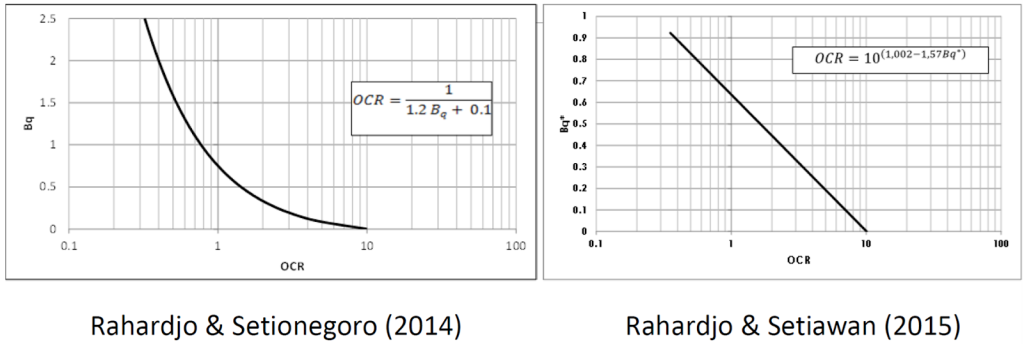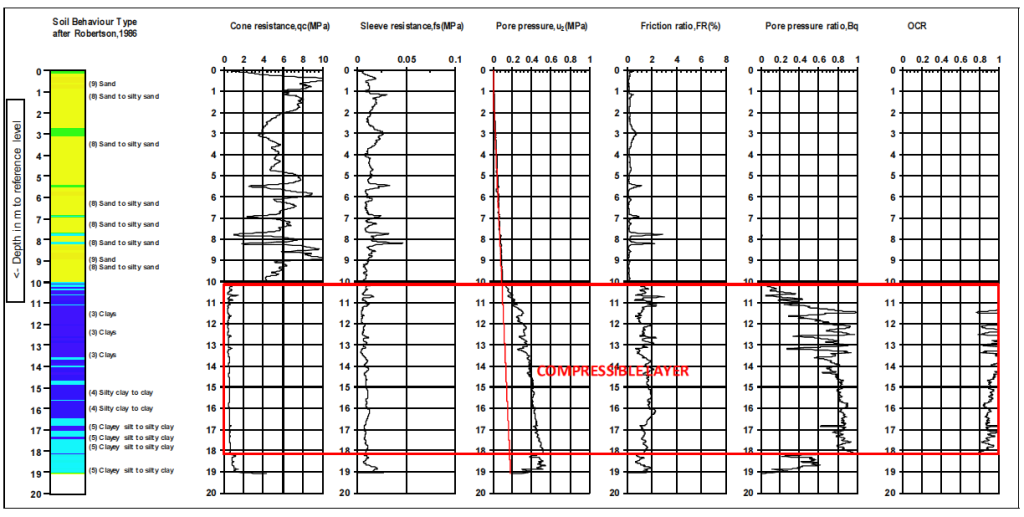Table of Content
Piezocone Test / CPTu
- Correlation Between Pore Pressure Ratio (Bq) with Degree of Consolidation (U)
- Correlation Between Modified Pore Pressure Ratio (Bq*) with Degree of Consolidation (U)
- CPTU in Ultra-Soft and Very Soft Marine Clays and Silts in North Jakarta Coastal Area
- Evaluation of the Degree of Consolidation of Coastal Reclaimed Lands Based on Settlement Data and CPTU
CORRELATION BETWEEN PORE PRESSURE RATIO (Bq) WITH DEGREE OF CONSOLIDATION (U)
Research Team : Dr. Nurindahsih Setionegoro, Prof. Dr. Ir. Paulus P. Rahardjo, MSCE.
Year : 2013 & 2014
The consolidation of soil is closely related to the pore water pressures and hence associated with pore pressure ratio (Bq). This research collected piezocone tests data in underconsolidating soft Jakarta clays and
silts and established a correlation between the pore pressure ratio (Bq) and the overconsolidation ratio (OCR) or degree of consolidation. Subsequently, Rahardjo (2015) modifying this relationship by removing outliers and proposed the relationship between Bq and OCR. OCR less than unity means the degree of consolidation, and higher than one means Overconsolidation Ratio (OCR). It should be noted that the available data was at the lowest degree of consolidation of 30%.
However, the suggested correlation was OCR = 1/(1.2 Bq + 0.1) and may be extended to a lower degree of consolidation.

CORRELATION BETWEEN MODIFIED PORE PRESSURE RATIO (Bq*) WITH DEGREE OF CONSOLIDATION (U)
Research Team : Ricky Setiawan, ST., MT., Prof. Dr. Ir. Paulus P. Rahardjo, MSCE.
Year : 2016 & 2017
This research proposed a modified pore pressure ratio (Bq*) to check the proportion of the excess pore pressure response to the cone resistance. The Bq* parameter is a unique parameter that does not require an assumption of soil unit weight as in the pore pressure ratio, Bq. Moreover, Bq* is intended to observe the ratio of the measured porewater pressure and tip resistance.
This research later developed a relationship between the Bq* and Bq, which were based on piezocone tests performed on the mud disaster area in Sidoarjo, East Java –Indonesia. The tests have been used to give an understanding of the engineering characteristics of the mud.


CPTU IN ULTRA-SOFT AND VERY SOFT MARINE CLAYS AND SILTS IN NORTH JAKARTA COASTAL AREA
Research Team : Aflizal Arafianto, ST., MT., Prof. Dr. Ir. Paulus P. Rahardjo, MSCE.
Year : 2022
Abstract : The use of CPTu in soft soils are widespread. Usually, the CPTu tip resistance measures soft soils response as soil resistance as well as pore water pressure due to penetration of the cone during insertion into the soils. However, when CPTu is conducted in very soft soils and ultra-soft soils, the soil resistance is very low, and pore pressure dominates the proportion of the resistance. Hence CPTu is the best tool to investigate the behavior of soft soils as well as ultra-soft soils. Before penetration testing, the initial excess pore pressure has not entirely diminished. In this case, the measured excess pore water pressure shall be interpreted as combined existing pore water pressure (hydrostatic and residual excess pore pressure) and the additional excess pore water pressure due to cone penetration. This paper represents research results of CPTu in reclaimed soils and deposited dredge mud, which was dumped in the area in 2016. Additional data were obtained recently in 2019. However, the degree of consolidation of soft soils practically did not change, but the dredge mud deposit slightly change.
The authors have developed methods for the interpretation of these combined excess pore water pressures to predict the degree of consolidation and strength. The methods can separate the excess pore water pressure due to penetration and the prior existing pore water pressure. The methods for interpretation of the degree of consolidation include the use of the Schmertmann method (which is found suitable for a naturally deposited deposit but not suitable for reclamation case histories), the use of pore pressure ratio (Bq) value, and the dissipation curve with considering the existing excess pore water that still exists. Recently, Rahardjo (2016) has developed the use of Modified Pore Pressure Ratio (Bq*), which is defined as porewater pressure (u2) divided total tip resistance (qt). This development is essential for very soft soils and ultra-soft soils. When carefully examined, the tip resistance profiles will not form a linear tip resistance (not straight line). Hence, the interpretation was made considering the initial (remaining) excess pore pressure or the effective stress at a particular time. Furthermore, a new approach to the degree of consolidation prediction has been proposed by Rahardjo (2014, 2015) and Rahardjo et al. (2017). The methods have been proved to be consistent and have the potential for prospective future interpretation. In conclusion, this research has been able to characterize the behavior of very soft soils and ultra-soft soils.


EVALUATION OF THE DEGREE OF CONSOLIDATION OF COASTAL RECLAIMED LANDS BASED ON SETTLEMENT DATA AND CPTU
Research Team : Kirana Rongsadi, ST., MT, Susana Dewi Santoso, ST., MT., Aflizal Arafianto, ST., MT., Prof. Dr. Ir. Paulus P. Rahardjo, MSCE.
Abstract : Reclamation works in coastal area has started to be done a lot in Indonesia due to the increasing of land requirements caused by population growth. There are some important geotechnical problem in reclamation works to be concerned such as the density of compacted fill material related to the liquefaction potential due to the earthquake, the slope stability of fill works along the construction period, and one of the main issue is the degree of consolidation of the very soft sub soil. This paper is focused to address the evaluation of the degree of consolidation of coastal reclaimed land based on the settlement monitoring and CPTu (piezocone) data using various method of interpretation. Method of interpretation used for settlement data is from the generally used method such as hyperbolic extrapolation method, Asaoka’s method, and 1/T vs settlement method for settlement data. And the relatively new interpretation method of degree of consolidation of the underconsolidating soil based on the CPTu data such as Bq vs U method (Setionegoro, 2013 and Rahardjo et al., 2016) and effective stress approach from the measured qc (Santoso and Rahardjo, 2016). The results of the study show that interpretation of the degree of consolidation using CPTu data is consistent to the settlement measurement except that the method ignore secondary compression.



